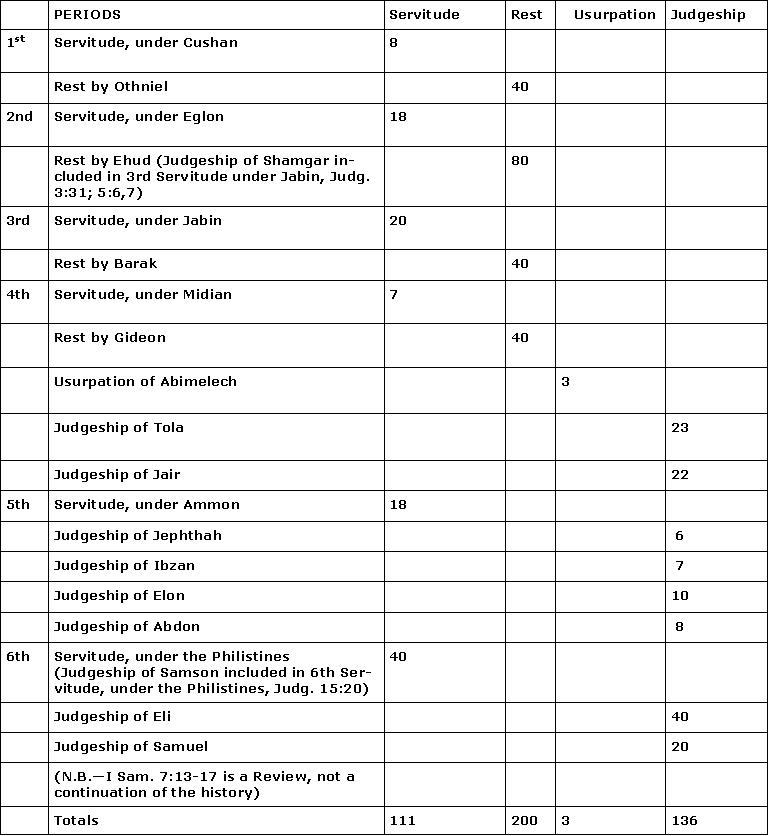|
IV. THE PERIOD FROM JAIR TO SAUL
Having verified the chronological data found in Judges 3-10 with the blanket statement of 300 years mentioned by Jephthah from the 40th year of the Exodus to the last year of Jair, we are now prepared to investigate the remaining chronological data found in the books of Judges and I Samuel 1-7. To the 22 years of Jair's reign we add the 18 of Ammonite oppression (10:8), and this total we augment with the following: 6 years for Jephthah's administration (12:7); 7 for Ibzan; 10 for Elon; 8 for Abdon (12:14). This gives us a total of 71 years for these minor judgeships and the one servitude under Ammon.
At this time Israel sinned again, and the Lord once more delivered her into the hands of the Philistines for 40 years (13:1).During this oppression Samson judged Israel for 20 years (15:20; 16:31). These are not to be used in the computation of the chronology since they coincide with the 40 years of the Philistines.
Following the Philistine servitude was the judgeship of Eli, who held office for 40 years (I Sam. 4:18). He was succeeded by Samuel the prophet, who judged Israel during the time the ark of the covenant was at Kiriath-jearim--20 years. It is clear from the narrative that Samuel's tenure of office followed that of Eli.
At the end of this 20-year period there was a mighty turning to God on the part of Israel who had been more or less indifferent to spiritual things, and who had even gone off into idolatry. When the Philistines heard of this great revival, they invaded the country. But Samuel led the people, who were helped of the Lord. A great deliverance was wrought. A stone was set up to commemorate the victory. This was at the end of Samuel's 20 years of judgeship.
A careful reading of I Samuel 7:13-8:3 shows that this section is a resume of Samuel's administration, looking both backward and forward from this special occasion. In the following paragraph we learn of the demand which the people made for a king. As we shall presently see, this new departure followed the Philistine invasion.
The period of office of the minor judges amounts to 71 years, which brings us 71 years after Jephthah's speech, namely, to 2923. To this total we add 40 years for the Philistine oppression, 40 for the Judgeship of Eli, and 20 years for the administration of Samuel. The times of the judges, therefore, terminated with the year 3022. The monarchy began in 3023 A.H.
As seen in the tables under Section III and the data just presented, the total number of years for the judges was exactly 450. This is what the apostle Paul clearly declared in Acts 13:19,20. There is perfect harmony between the data found in Judges and the statement of the great apostle.
When we add to this number the 14 years of the Joshua-Judges chasm, the 6 years of conquest of Canaan, the 40 of the wilderness experiences, and the 84 years of the reigns of Saul, David, and Solomon to the latter's fourth year, we have a grand total of 594 years. Thus by pure calculation we see that there were 594 years from the Exodus to the fourth year of Solomon when the temple was started. But in I Kings 6:1 we learn that there were only 480. There is a discrepancy of 114 years. When we remember that, during this time Israel was out of fellowship for the 111 years of the servitudes and the 3 years of the usurpation of Abimelech, we see that she was in God's favor only 480 years of the 594. In view of these facts we must consider these 480 years as theocratic. God's clock, figuratively speaking, stops when Israel is out of favor with her Maker.
With the close of the 20 years of the judgeship of Samuel, a new era was ushered in known as the monarchy, which will be discussed in the next chapter. Thus in our tracing the chronological question we have come to the year 3022 as the last of the 20 years of Samuel's administration. The first year of the monarchy, as we shall see was 3023 A.H.
End Of Chapter VII.
|
|
